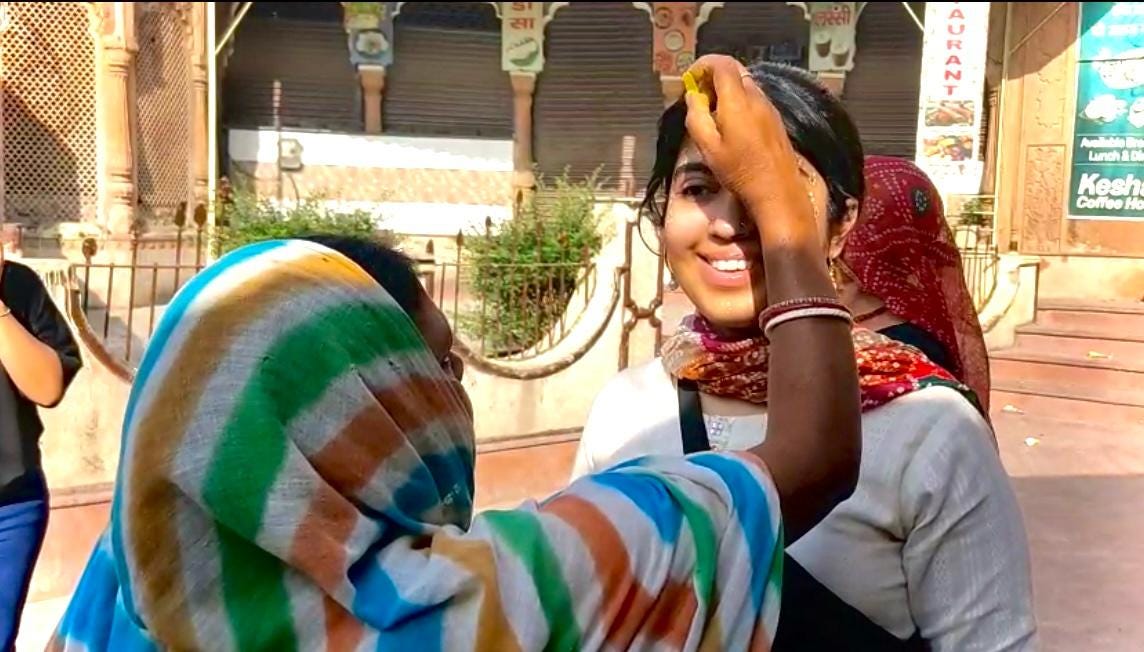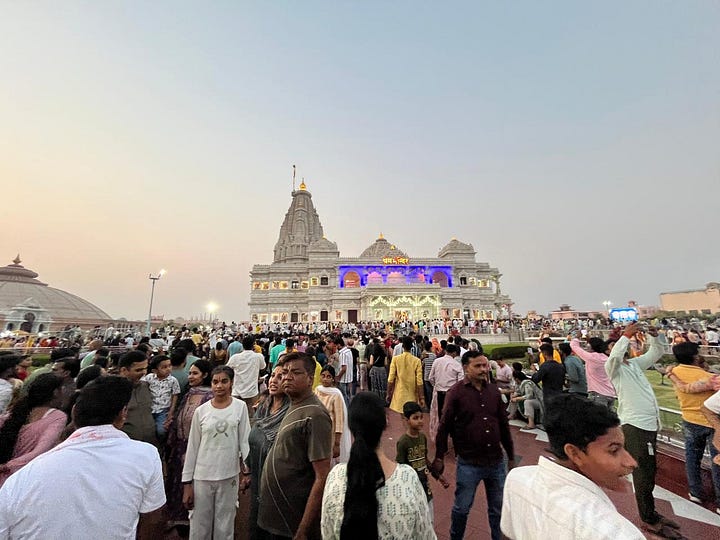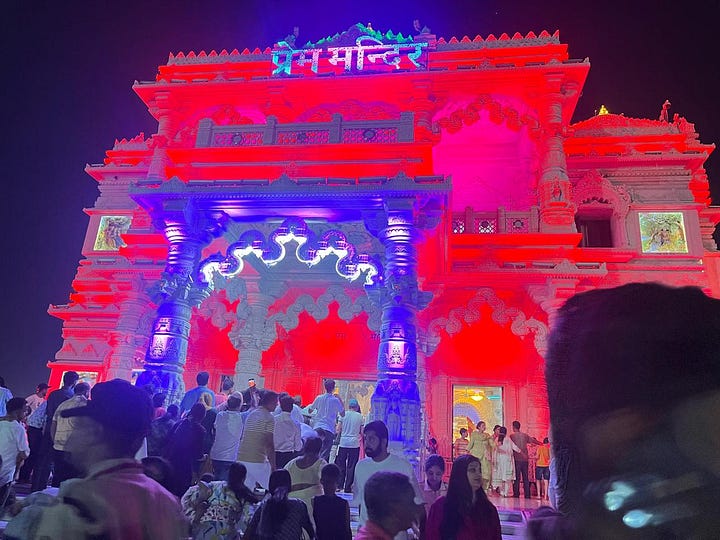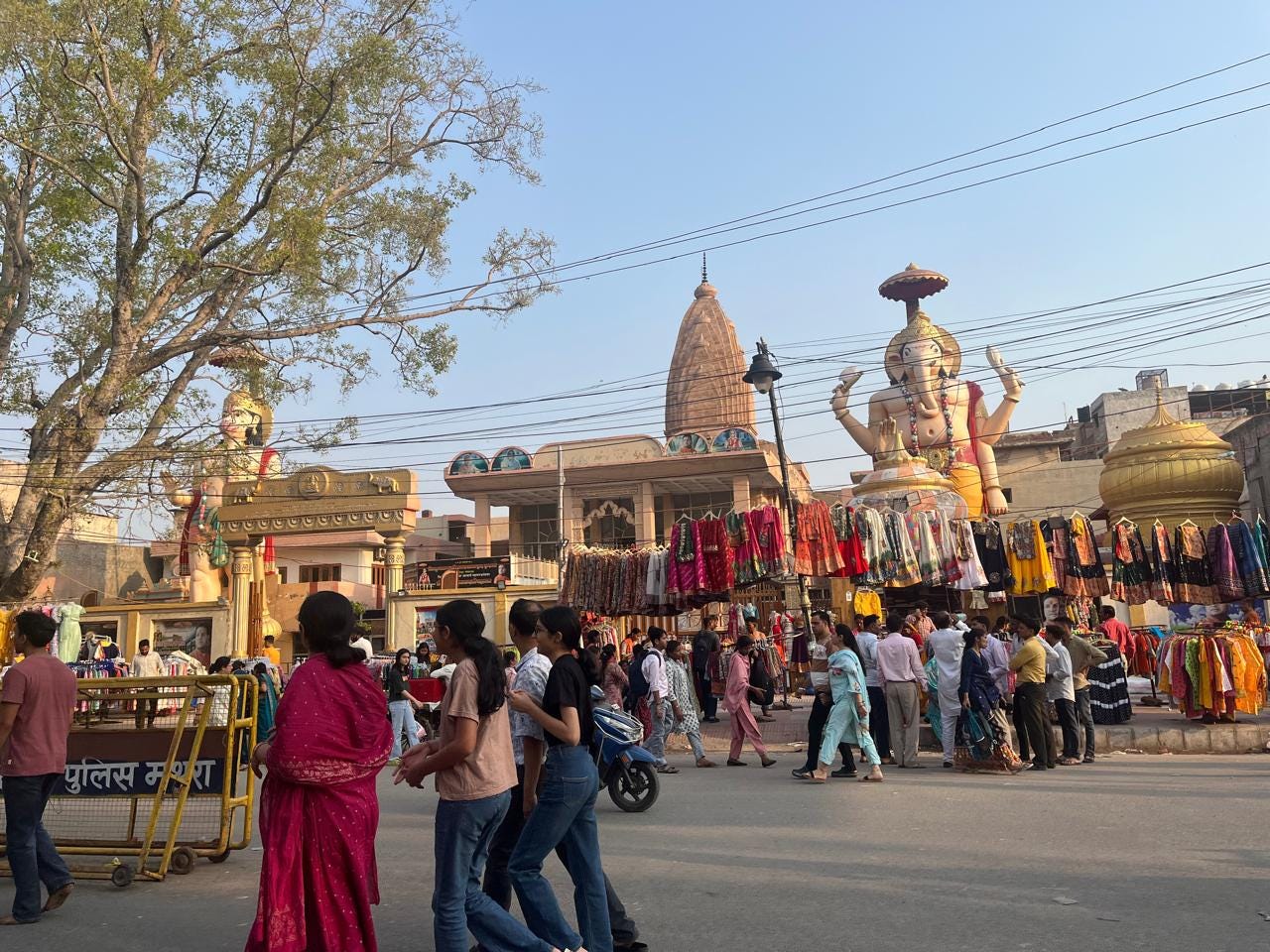Context: As my Braj Yatra came to a halt at the ultimate destination of every Braj Yatri—Vrindavan—I mused on Krishna’s form as the lover of Radha. I found myself lost in reflections that left me with more answers than questions. What questions? Read below to introspect with me…
The ultimate destination for any Braj pilgrim is Vrindavan.
Here, every second street houses a shrine. The entire town buzzes with Krishna bhakti.

Every shop—and every person—is engaged in the tourism business.
And it’s not just humans who trade. Even the monkeys are in on it.
In Vrindavan, you simply can’t wear specs. Monkeys snatch everything. You have to bait the monkeys with frootis from nearby shop to barter your specs or phone back. So Monkeys are in a way sales agents.
Come home and Dad and Dadi will animatedly share tales of relatives losing their glasses (and other belongings) to the monkeys.
If I were Lenskart, I wouldn’t even try opening a store here.
Dad and I got curious—what do the locals do if they develop a weak vision?
Wearing lenses all day isn’t exactly sustainable.
So, what’s the workaround? Radhe Radhe!
Being a weekend—and a long weekend thanks to Ambedkar Jayanti—it felt like all religious fanatics, casual travelers, and lay tourists had collectively decided to camp here.
We were stuck in a standstill traffic jam and peddlers even sold chai as if it were a railway platform!
What amazed me most was how, at 7 a.m., the town was already throbbing with life.
People were helping themselves to greasy kachoris, chai, samosas, and thick lassi.
We thought we were being smart waking up early— Only to be outwitted by Delhi folks who drove in at 4 a.m. and queued up by 6 ;)
Overwhelmed by the crowds, we skipped the two iconic temples—Banke Bihari and Radha Vallabh Mandir (I was roaming without specs and couldn’t risk my phine being snatched hence no photos rom morning bit ;)
Instead, we headed to Nidhivan—a place of mystery and legend.
It’s said that every night, Krishna and Radha perform their Rasleela here. The shringaar samagri (decorative items) kept for them is found used by morning. The Tulsi plants in the area are believed to be embodiments of the gopis.
The curious me wanted to stay overnight and witness for myself if this truly happens—only to be jabbed by fellow revelers, who echoed tales of journalists and other curious souls like me losing their senses in the process as they couldn’t stand their immense beauty.
Legend has it that Bankey Bihari (shrine in the temple) is the combined rupa (form) of Radha and Krishna—an exquisite vision of divine love so overwhelming that mortals couldn't bear it.
It is said that Swami Haridas, their ardent devotee, requested them to appear in a unified form for the benefit of devotees.
Until that moment, I thought only Ardhanarishwara—the blend of Shiva and Parvati—held that space of divine duality.
But now? I’ve added one more to my cosmic list of love-infused oneness.
While curiosity defines me, this time, fear won the battle.
Food for thought: In this era of science, technology, psychology, and AI, it's remarkable how faith-based systems not only persist—but thrive.
The science vs. religion debate may rage elsewhere, but in Vrindavan, there’s no room for such arguments. Here, faith is more than belief—it’s big business. And who would trade money for mere opinions?
Bhakti = Business
The entire belt of Braj throbs with the chant of Radhe-Krishna. It’s everywhere — in the air, on the streets, etched into every wall. You can’t escape it.
Yet, across my entire sojourn, I came across only a handful — maybe even fewer — devotees and locals who truly seemed to live by its spirit. The bhakti felt more like an echo than an essence. Loud, yes. But hollow.
Take the major temples, for instance. In Nidhivan, loudspeakers blared recorded messages telling people ‘Line me khade rahe, jeb katron se savdhaan rahe’ (stay in line, beware of pick-pockets).
The priests looked like they were on autopilot—unwrapping the Shringar Samagri, brushing it against the idol, and handing it back within seconds. That’s it. It had ‘touched’ the divine. Tick mark. Move along. Make way for the next.
Some priests looked more like vyapaaris — fanning ₹500 notes in their fingers like poker chips, inviting more donations. Their hands moved like tongs — roasting their meals off the faith of the faithful. It was mechanical, transactional, almost unsettling.
What hit me harder was the contrast — in the house of the makhan chor, the innocent Krishna, real thefts were happening. Police were constantly announcing warnings to hold on to your belongings. My dad spoke of gold chains that had “evaporated” in temple crowds.
It made me wonder — who is stealing from whom here? At a place where people come to cleanse soul of crimes, people commit crimes! Ironic!
And then came the biggest blow — the dalals of Vrindavan. Charging ₹300–₹400 per person to get a shortcut darshan at major shrines. “Avoid the line, take the side route, and you’re done.” Just like that. Paid devotion. Fast-track faith.
This VIP culture isn’t new. It’s a pan-India phenomenon. I’ve heard people boast, “Badiya darshan ho gaya approach se” — not just in Braj, but in places like Vaishno Devi and even Ayodhya now.
And it makes me pause. How do we reconcile with this version of devotion? Does seeing Bhagwan for two seconds really wash away all our flaws?
To me, this mindset reflects a very narrow view of religion — that God is only present in a murti, and can only be pleased if we see Him in person. But isn’t that idea itself flawed?
Personally, I always believed that faith was meant to be a discipliner — a force that grounded you, gave you inner stillness, made you better. But here, in the very land where Krishna once walked, it seemed like there were more culprits hiding behind saffron than in regular society.
In the Mahabharata, when Krishna reveals his Viraat Roop, he clearly says — He exists in everything. He is not confined to a statue or a shrine. He is in the trees, the earth, the sky, within each of us — if only we have the eyes to see, the patience to sense.
We don’t need these priests-turned-middlemen to fast-track our reach to Him. Bhagwan sits quietly within us — if we’re ready to pause, breathe, and truly feel.
To truly experience a mandir, sometimes all you need to do is just walk into its premises. Soak in the calm. Feel the aura. Let the silence speak. Instead of racing to touch the divine, try to connect with the divinity within.
Personally, I find the satsangs at ISKCON the most beautiful form of Krishna bhakti. There’s joy, rhythm, and surrender in dancing to Radha-Krishna songs. There’s something deeply raw and real in that moment — a taste of Krishna consciousness that feels more honest than rushed darshans.
And if this write-up isn’t convincing enough, just read Kabir. See how he tears down blind ritualism and exposes the ridiculousness of our religious games. He reminds us — the divine doesn’t live behind locked doors and donation counters.
He’s right here. Within. Always has been.
Parting Thoughts
While walking through the opulent premises of the majestic Prem Mandir, the entire trip started going in rewind in my head.


I just stood in awe of the grand power of religion. It is just like an automatic response of the body—belief comes before books in our life.
Before we even comprehend what religion means, we are classed into one system of thought.
It becomes a part of our primal brain—so deeply seeped that we are ready to move mountains to safeguard this first skin.
While making my way through the sea of devotees—some mesmerized by the light show, others clicking selfies near the fountain depicting Krishna overpowering Vasuki Naag, or admiring the Jhanki (display 3D form) of him lifting Govardhan—I was suddenly transported back to a recent talk I had delivered.
It was on how psychology-based interventions can help combat air pollution. One key point I remember emphasizing was the powerful role religious leaders can play in championing this cause.
And my Braj Yatra kind of fueled life into my dream.
What better place than religious sites to advertise about the cause?
In India, 60 percent of tourism is religious tourism.
Just imagine the mammoth scale of impact these epicenters can create.
Kumbh Mela, as per government estimates, moved around 60 crore people. Now imagine: what if the message of environmental responsibility echoed through these gatherings, woven seamlessly into the spiritual fabric?
How to do it?
Religious Leaders
If I were to name, Premanand Maharaj has 541K followers on Instagram, Sadhvi Bhagawati Saraswati has 168K, and Jaya Kishori has 12.2 million followers on Instagram. The advice of religious leaders is like gospel advice—whatever they say becomes a precedent for scores of people. Their perspectives can tilt elections, then imagine the power they hold. If they start practicing eco-friendly activities and post on their reels and stories—of cleaning the temple premises, shunning plastic, and worshipping earth as a god—I’m certain people will follow.
AV and Posters
At Prem Mandir—and many other temples—I noticed posters narrating stories of the temple’s patrons and the divine legends of gods. It made me wonder: what if we created compelling visuals of saints and spiritual leaders stirred by the cause of the environment? Just like Sadhguru Jaggi Vasudev’s Save Soil movement inspired millions, imagine the impact if similar campaigns were rooted in spiritual storytelling.
Traditional Values
In Hindu traditions, the concept of seva is so poignant. Taking up volunteers as sevadars who participate in cleanup drives and showing their visuals on big screens can give a huge boost. Standing next to Govardhan Parbat, I wondered—why not simply worship Govardhan Parbat, but the entire land? Bhagwan Shree Krishna walked the entire Braj, not just Govardhan.
If the whole earth belongs to God, then why do we inflict pain on it? Orienting people on religious principles can make a big impact.
Consider the case of the Bishnois—they have been safeguarding the land relentlessly for centuries as per the teachings of their Guru. They even sacrificed their lives to protect flora and fauna. Can we also extend religious belief to the planet?
I remember reading this verse from Amish Tripathi’s novel, quoted from Adbhut Ramayana:
“यदा यदा हि धर्मस्य ग्लानिर्भवति सुव्रते।
अभ्युत्थानमधर्मस्य तदा प्रकृतिसम्भवाः॥”
Yada yada hi dharmasya glanir bhavati suvrata,
Abhyutthanam adharmasya, tada prakriti sambhavah.
When adharma rises or dharma is in decline, the sacred feminine will incarnate.
The Prakriti, Mother Nature, shall take revenge if not taken care of. If religious leaders can deliver sermons elaborating on these sayings, we can spread the word of environmental conservation.
I keep seeing my relatives uploading WhatsApp statuses and stories featuring the sage advice from gurus—the reach of WhatsApp University is deep. If we can have creatives to circulate these messages, it can be a huge gain!
“Brajbhoomi hai paawan dharti, iski beauty hamari duty!”
“Radhe Radhe, apne vatavaran ko swachh rakhein!”
Next to water sources, we can paste adjuncts:
“This lake is an embodiment of Varuna Devta, the ocean god. Spoiling this, you may disturb the balance…”
In a Nutshell:
My mind went places with creative ideas on how we can start a revolution in the city of Braj and similarly spread to mosques, synagogues, churches, and more.
The dream seems fancy yet realistic.
Perhaps the environment can be one theme that unites us all—
Floods cause damage irrespective of religion,
Droughts disturb all equally.
Only if we could abide by the vision of dharma—dharma of Prakriti, beyond the garb of religious dharma.
Just like every travel, my Braj Yatra opened my horizons to new thoughts and possibilities.
It was just one roop of Krishna that this Yatra showed me.
Hope Bankey Bihari blesses me to understand their other forms—in Dwarka, Jagannath Puri and more.
Cheers!






